To support the transmission rate of 400Gbit/s, the 4-channel x100Gbit/s transmission mode using PAM modulation can reduce the design complexity and energy consumption of the transceiver. It is noted that compared to external modulation-based Mach-Zehnder modulators (MZMs), the internal modulation schemes using Electro Absorption Modulated Laser (EMLs) and directly modulated lasers (DMLs) are less expensive and simpler in design.
But two bottlenecks limit the performance of the system: the modulation bandwidth limitation of the optoelectronic device and the nonlinear impairment problem during modulation and demodulation. Many digital signal processing (DSP) methods have been proposed to address these two limitations, such as judgment feedback equalization, nonlinear Volterra equalization, etc., all of which require high computational complexity at the receiver side.
PAM4 technology
Due to the requirements of 400G technology, it is necessary to apply single-channel 56G- or 112G- rate requirements, but the channel loss and reflection introduction cost of 56G/112G signals are too high, and the tolerance to channel crosstalk is greatly reduced. The current NRZ technology is difficult to break through the single-channel 56G transmission rate. Therefore, the industry introduced PAM4 technology to solve it.
PAM4 is a kind of PAM (Pulse Amplitude Modulation) technology. Its modulation methods include DSP-based digital DAC implementation methods and analog-based Combine methods. The mainstream analog mode can operate by adding two channels of NRZ signals, and the digital model is based on a high-speed DAC for fast output of 0/1/2/3 levels.
As shown in the figure, PAM4 is modulated by four-level amplitude, and each level value can carry two-bit information, at the cost of being more sensitive to noise. If we look at the eye diagram of an NRZ signal, assuming that the bit period is T and the amplitude is A, then the channel bandwidth is the inverse of the bit period (1/T). The higher the bit rate, the smaller the bit period and the larger the signal bandwidth. There is also a signal-to-noise ratio (SNR) requirement, which is related to the signal amplitude. Viewed vertically, the smaller the eye diagram opening, the more difficult it is to distinguish the original signal from the receiver at a fixed signal-to-noise ratio.

Figure1:Schematic diagram of the PAM4 principle
Is there any other way to double the bit rate? One way is to serialize the two-bit streams. Use one 56Gbit/s channel instead of two 28Gbit/s channels. So in the original 28Gbit/s rate cycle, the current rate reaches 56Gbit/s. As can be seen from the eye diagram of the signal ML, its amplitude is still A, but the period becomes T/2. If the bit period is reciprocated, the signal bandwidth 2/T is obtained. A remains unchanged, that is, the signal-to-noise ratio remains unchanged, but the signal bandwidth is doubled.
We need a way to multiply the bit rate without increasing the bandwidth, and this is where PAM4 excels. The eye diagram of the PAM4 is unusual, with 3 open eyes and 4 amplitudes when viewed longitudinally, with a symbol period of T. However, the opening range of each eye is A/3, and the corresponding bandwidth requirement is 1/T. In this way, we get a 56Gbit/s signal, which is the same as the M or L bandwidth of the 28Gbit/s single-channel signal, but the signal-to-noise ratio is related to A/3, so PAM4 has a trade-off between the signal-to-noise ratio and the signal bandwidth.
Many serial links are bandwidth constrained, so it is difficult to increase 28Gbit/s by shortening the bit period. However, when there is room for SNR, it is a good choice to sacrifice part of the SNR cost in exchange for the PAM4 scheme with a doubled rate.
What is DSP technology?
For short-distance optical communication systems, the main factors to be considered are: 1) chromatic dispersion, that is, different wavelengths correspond to different group velocities, resulting in pulse broadening and signal distortion. Therefore, the O-band with smaller chromatic dispersion is selected for working wavelength; 2) low-pass filtering effect caused by insufficient device bandwidth; 3) polarization rotation. Due to the short transmission distance, the polarization mode dispersion is not considered. The influence brought by these factors can be compensated by DSP.
DSP is digital signal processing technology, and DSP chip refers to the chip that can realize digital signal processing technology. It is a fast and powerful microprocessor. The unique feature is that it can process data in real time. The interior of the DSP chip adopts a Harvard structure with separate programs and data and has a dedicated hardware multiplier, which can be used to quickly implement various digital signal processing algorithms. In the context of the digital age, DSP has become a basic device in the fields of communications, computers, and consumer electronics.
In the short-distance optical communication system, the main functions of the transmitter DSP are:
1) FEC (forward error correction) coding technology. Its basic principle is to use the redundant coding method, which has the advantage of automatically correcting transmission errors.
2) Bit-to-symbol mapping
3) Re-sampling
4) Pulse shaping
5) DAC
The main functions of the receiver DSP are:
1) ADC
2) Re-sampling
3) Re-timing
4) Adaptive equalizer, which automatically adjusts its coefficients based on the measurement of channel characteristics to adapt to changes in channel characteristics, compensate the signal, and eliminate inter-symbol interference
5) FEC decoding
We compared the DSP configuration requirements corresponding to three different modulation methods. The three modulation formats are(1) PAM; (2) CAP (carrier-less amplitude and phase modulation); (3) DMT (discrete multi-tone modulation). The DSP configuration corresponding to these three modulation methods is shown in the following figure.

Figure2:DSP configuration corresponding to the three modulation methods
For PAM, pulse shaping and pre-emphasis functions at the transmitter are used to compensate for the bandwidth limitations of the DAC and the nonlinearity of the transmitter device. An adaptive equalizer at the receiver is used to compensate for losses at the transmitter and the channel.
For the CAP, the transmitter uses two shaping filters to form a quadrature amplitude modulation (QAM) signal. The function of pre-enhancement is similar to that in PAM encoding, which is also used for compensation. At the receiving end, the signal is divided into two channels for processing, and finally, the QAM signal is synthesized.
As for DMT, it boasts high spectral efficiency, high tolerance to loss, and flexible coding. On the transmitting side, the S/P function converts serial information into parallel blocks. The IFFT function converts the signal to the time domain. Interference between parallel blocks can be avoided by adding a cyclic prefix. On the receiving end, it is the inverse operation of the sending-end function.
The complexity of DSP directly affects the cost and power consumption of optical modules. The three modulation methods have some common DSP modules, including FEC codec, bit mapping/demapping, DAC, ADC, etc. In comparison, the PAM method requires fewer modules, and both CAP and DMT require additional filter units, which are more complicated. The pros and cons of these modulation methods are compared in the following table.

Table1:Comparison of the advantages and disadvantages of the three modulation formats
RS means receiver sensitivity, RIN means relative intensity noise. In comparison, the PAM-4 method is the best choice, it can realize short-distance optical communication simply, and has excellent performance. At present, most of the 400G demo optical modules are based on the PAM-4 method.
A very important part of the 400G QSFP-DD AOC is the design of the signal recovery circuit. In the past, signal recovery used CDR (clock and data recovery) circuits. In the electrical-optical conversion interface, the high-speed serial signal passes through the high-loss circuit board, resulting in serious degradation of the signal quality. The signal is recovered by the PAM4 CDR, thereby obtaining a low-jitter clock and data. At the electro-optical conversion interface, due to the insertion loss of the electro-optical modulator and the transmission loss of the optical fiber, the lossy signal received by the photo-detector also needs CDR for data recovery.

Figure3:DSP scheme based on PAM4 modulation
However, in terms of performance, the improvement of CDR for the entire circuit is far less than that of DSP. DSP is a high-speed digital processing chip. In addition to providing the digital clock recovery function that CDR can provide, it can also perform dispersion compensation operations on 400G QSFP-DD AOC products to remove interference factors such as noise and nonlinearity. Limited by the package size of the optical module, 400G QSFP-DD AOC doesn’t have many parallel channels and coupled with the limited bandwidth of electro-optical devices, people must increase the single-wave rate.
For single-wave applications above 100G, the current electrical driver chip and optical devices at the receiving end are unable to reach the bandwidth above 50GHz, so it is equivalent to introducing a low-pass filter at the transmitter side, which is manifested in the time domain as inter-code interference.
Taking the application of single-wave 100G PAM4 as an example, the modulation device with insufficient bandwidth will make the eye width of its signal very small. What’s more, the clock recovery based on the past analog PLL cannot find the best sampling point, so the receiver cannot recover the correct signal.
After the introduction of DSP, the signal can be directly compressed at the transmitting end, and the signal can be recovered by the adaptive FIR filter at the receiving end. This method can change the influence of the uncontrollable analog bandwidth in the modulation/reception device into a known digital spectrum compression, reducing the need for optical device bandwidth.

Figure4:Eye diagram of FiberMall 400G QSFP-DD AOC
In general, compared with the CDR circuit, the 400G QSFP-DD AOC product using the DSP solution has higher power consumption and cost. However, it has a better ability to process signals, mainly manifested in the strong electrical port adaptability, good optoelectronic performance, and so on.
Conclusion:
The above are the core technologies of 400G QSFP-DD AOC products – PAM4 and DSP technology. PAM4 technology overcomes the weak ability of traditional NRZ modulation at a 56G rate and doubles the bit rate without increasing bandwidth. However, PAM4 sacrifices the signal-to-noise ratio, making 400G QSFP-DD AOC products more sensitive to noise, and DSP chips just make up for the disadvantages of PAM4 technology.
Related Products:
-
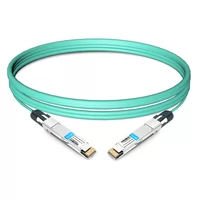 Cisco QDD-400-AOC3M Compatible 3m (10ft) 400G QSFP-DD to QSFP-DD Active Optical Cable
$665.00
Cisco QDD-400-AOC3M Compatible 3m (10ft) 400G QSFP-DD to QSFP-DD Active Optical Cable
$665.00
-
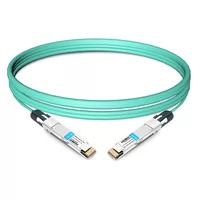 Mellanox C-DQ8FNM010-H0-M Compatible 10m (33ft) 400G QSFP-DD to QSFP-DD Active Optical Cable
$690.00
Mellanox C-DQ8FNM010-H0-M Compatible 10m (33ft) 400G QSFP-DD to QSFP-DD Active Optical Cable
$690.00
-
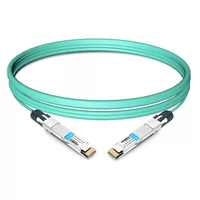 Arista Networks AOC-D-D-400G-15M Compatible 15m (49ft) 400G QSFP-DD to QSFP-DD Active Optical Cable
$710.00
Arista Networks AOC-D-D-400G-15M Compatible 15m (49ft) 400G QSFP-DD to QSFP-DD Active Optical Cable
$710.00
-
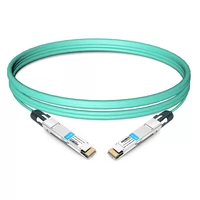 DELL AOC-Q56DD-400G-15M Compatible 15m (49ft) 400G QSFP-DD to QSFP-DD Active Optical Cable
$710.00
DELL AOC-Q56DD-400G-15M Compatible 15m (49ft) 400G QSFP-DD to QSFP-DD Active Optical Cable
$710.00
-
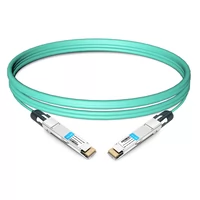 Juniper Networks QDD-400G-AOC-20M Compatible 20m (66ft) 400G QSFP-DD to QSFP-DD Active Optical Cable
$725.00
Juniper Networks QDD-400G-AOC-20M Compatible 20m (66ft) 400G QSFP-DD to QSFP-DD Active Optical Cable
$725.00
-
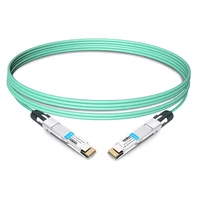 Mellanox C-DQ8FNM050-H0-M Compatible 50m (164ft) 400G QSFP-DD to QSFP-DD Active Optical Cable
$825.00
Mellanox C-DQ8FNM050-H0-M Compatible 50m (164ft) 400G QSFP-DD to QSFP-DD Active Optical Cable
$825.00
